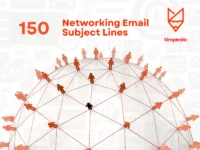Networking is an essential skill in today’s professional world. Whether you’re looking to advance your career, seek mentorship, or explore new opportunities, effective networking can open doors and create valuable connections. One of the most powerful tools at your disposal is the networking email. In this comprehensive guide, we’ll explore how to write a networking email that stands out, engages the recipient, and fosters meaningful relationships.
How to Write a Networking Email
1. Understanding the Purpose of a Networking Email
A networking email serves several purposes:
- Introduction: It allows you to introduce yourself to someone you may not know well or at all.
- Building Relationships: Networking emails help establish and nurture professional relationships.
- Seeking Advice or Information: You can use these emails to ask for guidance, insights, or information about a particular industry, job, or project.
- Exploring Opportunities: Networking emails can be a way to inquire about job openings, internships, or collaborative projects.
Understanding the purpose of your email will guide your writing and help you achieve your objectives.
2. When to Send a Networking Email
Timing is crucial when it comes to networking emails. Here are some scenarios when you should consider sending one:
- After Meeting Someone: If you’ve met someone at a conference, workshop, or networking event, send a follow-up email within 24-48 hours to reinforce the connection.
- Reconnecting with an Old Contact: If it’s been a while since you last spoke with someone, a networking email can help reignite the relationship.
- Before or After an Event: Reach out to individuals you plan to meet at an event or follow up with them afterward.
- When Seeking Advice: If you’re considering a career change or need guidance in your current role, a networking email can help you reach out to industry experts.
3. Components of a Networking Email
A well-structured networking email typically includes the following components:
Subject Line
The subject line is the first thing the recipient sees, so make it compelling and relevant. It should give the recipient a reason to open your email. Here are some tips for crafting an effective subject line:
- Be Specific: Mention the purpose of your email clearly.
- Keep It Short: Aim for 6-10 words to ensure it’s fully visible in the inbox.
- Create Curiosity: Use language that piques interest.
Examples:
- “Great Connecting at [Event Name]!”
- “Seeking Your Insights on [Specific Topic]”
- “Following Up on Our Conversation About [Project]”
Greeting
Start your email with a polite greeting. Use the recipient’s name to personalize the message. If you have a formal relationship, use their title (Mr., Ms., Dr., etc.); otherwise, a first name is usually appropriate.
Examples:
- “Dear Dr. Smith,”
- “Hi Jane,”
- “Hello Mr. Johnson,”
Introduction
In the introduction, briefly introduce yourself. Mention how you found their contact information or how you met (if applicable). This helps establish context and reminds the recipient of your previous interaction.
Example:
“I hope this message finds you well! My name is [Your Name], and I enjoyed meeting you at [Event Name] last week. I was fascinated by our discussion about [Specific Topic].”
Body
The body of your email is where you elaborate on your purpose for reaching out. Be clear and concise, and focus on the following points:
- State Your Purpose: Clearly explain why you are writing. Are you seeking advice, looking for a job, or hoping to collaborate?
- Include Relevant Details: Provide any necessary context or background information that will help the recipient understand your request.
- Be Respectful of Their Time: Keep your message brief and to the point. Busy professionals appreciate concise communication.
Example:
“I’m reaching out because I’m currently exploring opportunities in [Industry/Field], and I would greatly appreciate any insights you might have regarding [Specific Topic or Company]. Your experience at [Their Company] is inspiring, and I believe your guidance could be invaluable as I navigate my career path.”
Call to Action
End the body of your email with a clear call to action. This could be a request for a meeting, a phone call, or simply asking for their thoughts on your inquiry. Make it easy for them to respond.
Example:
“If you have some time in the coming weeks, I would love to schedule a brief coffee chat or phone call to discuss this further. Please let me know what works best for you!”
Closing
Finish your email with a polite closing. Thank the recipient for their time and consideration, and express your eagerness to hear back from them. Use a professional sign-off followed by your name and contact information.
Examples:
- “Thank you for your time, and I look forward to hearing from you!”
- “Best regards,”
- “Sincerely,”
Your Name
Your LinkedIn Profile (if applicable)
Your Contact Information
How to Write a Networking Email
4. Tips for Writing an Effective Networking Email
- Personalize Your Message: Tailor your email to the individual recipient. Mention specifics from your previous conversation or their work to show genuine interest.
- Be Professional: Use a professional tone and language appropriate for the context of your relationship.
- Proofread: Check for spelling and grammar errors before sending. A polished email reflects professionalism.
- Use a Clear Format: Use paragraphs and bullet points to make your email easy to read. Avoid large blocks of text.
- Follow Up: If you don’t hear back within a week or two, consider sending a polite follow-up email to reiterate your interest.
5. Common Mistakes to Avoid
- Being Too Formal or Informal: Striking the right balance is crucial. Avoid overly casual language, but also steer clear of being excessively formal if you have a friendly rapport.
- Writing a Novel: Keep your email concise. Long-winded messages can lose the reader’s attention.
- Neglecting the Subject Line: A vague or uninteresting subject line can lead to your email being overlooked.
- Failing to Do Your Research: Before reaching out, familiarize yourself with the recipient’s background and current work. This will help you craft a more relevant message.
- Not Being Specific: Vague requests can lead to confusion. Be clear about what you’re asking for.
6. Examples of Networking Emails
Example 1: After Meeting Someone at an Event
Subject: Great Connecting at [Event Name]!
Hi [Name],
I hope this message finds you well! My name is [Your Name], and I enjoyed meeting you at [Event Name] last week. I found our discussion about [specific topic] particularly engaging, especially your insights on [specific detail].
I’d love to stay in touch and explore potential opportunities to collaborate or share ideas. Would you be open to grabbing coffee next week? I’d love to hear more about your work at [Their Company].
Looking forward to hearing from you!
Best,
[Your Name]
[Your LinkedIn Profile]
[Your Contact Information]
Example 2: Seeking Advice
Subject: Seeking Your Insights on [Specific Topic]
Hi [Name],
I hope you’re doing well! My name is [Your Name], and I’m currently exploring opportunities in [Industry/Field]. I came across your profile while researching leaders in this area, and I was impressed by your experience at [Their Company].
I’m reaching out to see if you might have some time for a brief call or coffee chat. I would greatly appreciate any insights you could share regarding [specific topic or question]. Your expertise would be incredibly valuable as I navigate my career path.
Thank you for considering my request!
Best regards,
[Your Name]
[Your LinkedIn Profile]
[Your Contact Information]
Example 3: Reconnecting with an Old Contact
Subject: Long Time No See!
Hi [Name],
I hope this email finds you well! It’s been a while since we last connected at [Previous Company/Event]. I was reminiscing about our time working on [specific project or experience] and thought it would be great to catch up.
I’d love to hear about what you’ve been up to and share some updates from my end as well. Are you available for a coffee or a virtual chat in the coming weeks?
Looking forward to reconnecting!
Warm regards,
[Your Name]
[Your LinkedIn Profile]
[Your Contact Information]
Example 4: Following Up on a Job Lead
Subject: Following Up on Our Conversation
Hi [Name],
I hope you’re doing well! I wanted to follow up on our conversation at [Event Name] regarding the opportunities at [Company Name]. I’m very interested in the [specific position] and would love any additional insights you might have about the application process.
If you have a moment, I would greatly appreciate any advice you could share or if you could connect me with the hiring manager. Thank you for your assistance!
Best,
[Your Name]
[Your LinkedIn Profile]
[Your Contact Information]
Example 5: Thanking a Mentor
Subject: Thank You for Your Guidance
Hi [Name],
I hope you’re having a great day! I wanted to take a moment to thank you for the invaluable guidance you provided during our last conversation. Your insights on [specific topic] have helped me tremendously as I navigate my career.
I’d love to keep in touch and continue learning from your experience. Would you be open to a follow-up chat in the coming weeks?
Thank you once again for your support!
Sincerely,
[Your Name]
[Your LinkedIn Profile]
[Your Contact Information]
Example 6: Requesting a Meeting
Subject: Let’s Connect!
Hi [Name],
I hope this message finds you well! My name is [Your Name], and I recently came across your profile while researching leaders in [Industry/Field]. I was particularly impressed by your work on [specific project or achievement].
I would love the opportunity to connect and discuss your experiences in the industry. If you’re available, would you be open to a coffee chat or a virtual meeting?
Thank you for considering my request!
Best regards,
[Your Name]
[Your LinkedIn Profile]
[Your Contact Information]
Example 7: Following Up After a Conference
Subject: Great Insights at [Conference Name]
Hi [Name],
I hope you’re doing well! I wanted to reach out and express my appreciation for your presentation at [Conference Name]. Your insights on [specific topic] were both informative and inspiring.
I’d love to connect and discuss your work further, as I believe there are some overlapping interests we could explore. Would you be open to a brief chat in the next week or two?
Looking forward to hearing from you!
Warm regards,
[Your Name]
[Your LinkedIn Profile]
[Your Contact Information]
Example 8: Asking for a Referral
Subject: Request for Referral
Hi [Name],
I hope this email finds you well! I’m reaching out because I’m currently applying for a position at [Company Name], and I noticed that you have a connection there. If you feel comfortable, I would greatly appreciate it if you could refer me or provide any insights about the company culture.
Thank you for your support, and I hope we can catch up soon!
Best,
[Your Name]
[Your LinkedIn Profile]
[Your Contact Information]
Example 9: Expressing Interest in a Collaboration
Subject: Exploring Collaboration Opportunities
Hi [Name],
I hope you’re having a great day! I enjoyed our conversation at [Event Name] about [specific topic]. Your work in [specific area] aligns closely with some projects I’m currently working on, and I believe there could be great synergy between our efforts.
Would you be interested in discussing potential collaboration opportunities? I’d love to explore this further over coffee or a virtual meeting.
Looking forward to your thoughts!
Best,
[Your Name]
[Your LinkedIn Profile]
[Your Contact Information]
Example 10: Following Up on a Previous Email
Subject: Following Up on My Previous Email
Hi [Name],
I hope you’re doing well! I wanted to follow up on my previous email regarding [specific topic]. I understand you’re busy, but I would greatly appreciate any insights or guidance you could provide.
If you have a moment, I’d love to hear your thoughts. Thank you for considering my request!
Best regards,
[Your Name]
[Your LinkedIn Profile]
[Your Contact Information]
Writing a networking email is an essential skill that can significantly enhance your professional relationships. By following the guidelines outlined in this comprehensive guide, you can craft effective networking emails that resonate with your recipients. Remember to personalize your messages, be clear about your intentions, and maintain a professional tone.
Networking is not just about asking for favors; it’s about building genuine relationships. By approaching your networking emails with sincerity and respect, you’ll create lasting connections that can benefit both you and your contacts in the long run.
As you embark on your networking journey, keep these key takeaways in mind:
- Be Authentic: Show genuine interest in the recipient and their work.
- Be Specific: Clearly articulate your purpose and what you hope to achieve.
- Follow Up: Don’t hesitate to reach out again if you don’t receive a response.
- Stay Connected: Networking is an ongoing process. Regularly check in with your contacts, share relevant articles or resources, and engage with them on platforms like LinkedIn. This helps keep the relationship alive and shows that you value their insights.
- Be Patient: Building a network takes time. Not every email will yield an immediate response or result in a meeting. Be patient, and continue to nurture your connections.
- Offer Value: Networking is a two-way street. Whenever possible, look for ways to provide value to your contacts. This could be sharing industry insights, introducing them to someone in your network, or offering assistance with a project.
- Leverage Social Media: In addition to email, use platforms like LinkedIn to connect with professionals in your field. Engage with their posts, comment thoughtfully, and share relevant content to increase your visibility.
- Maintain Professionalism: Always maintain a professional demeanor in your communications. This includes being respectful of their time, using proper language, and maintaining a positive tone.
- Utilize Templates: While personalization is key, having a few templates can save time and help you structure your emails effectively. Just ensure that you customize each one to fit the specific individual you’re contacting.
- Reflect on Your Progress: Periodically assess your networking efforts. Are you making meaningful connections? Are your emails getting responses? Use this reflection to refine your approach and improve your networking strategy.
Additional Resources
To further enhance your networking skills and email writing, consider the following resources:
- Books:
- “Never Eat Alone” by Keith Ferrazzi – A classic on networking and building relationships.
- “The Networking Survival Guide” by Diane Darling – Offers practical tips on networking effectively.
- Online Courses:
- Platforms like Coursera, LinkedIn Learning, and Udemy offer courses on networking, communication skills, and professional development.
- Networking Groups:
- Join professional organizations or networking groups in your field. These can provide opportunities to meet new contacts and learn from others’ experiences.
- Mentorship Programs:
- Look for mentorship programs that connect you with experienced professionals in your industry. A mentor can provide invaluable advice and introduce you to their network.
In today’s interconnected world, the ability to write an effective networking email is more important than ever. Whether you’re a recent graduate, a seasoned professional, or someone looking to make a career change, mastering the art of networking can significantly impact your career trajectory.
By following the guidelines in this blog, personalizing your communications, and approaching networking with a genuine desire to build relationships, you’ll be well on your way to creating a robust professional network. Remember, every connection has the potential to lead to new opportunities, insights, and collaborations.
As you embark on your networking journey, keep these principles in mind, and don’t hesitate to reach out to others. You never know where a simple email might lead!
Example Scenarios for Networking Emails
To further illustrate how to effectively use networking emails, here are a few scenarios where you might find yourself needing to reach out:
- After Attending a Webinar or Workshop:
- If you attended a webinar and found a speaker particularly inspiring, send them a thank-you email expressing your appreciation for their insights and asking any follow-up questions you may have.
- When Transitioning Careers:
- If you’re shifting to a new industry, reach out to contacts who are already established in that field. Ask for informational interviews to learn more about their experiences and advice on making the transition.
- When Moving to a New City:
- If you’re relocating, reach out to connections in your new city. Ask for recommendations on local networking events, professional groups, or potential meetups.
- When Starting a New Project:
- If you’re launching a new project, consider reaching out to colleagues or contacts who have relevant experience. Ask for their insights or if they’d be willing to collaborate.
- When You’ve Read an Interesting Article:
- If you come across an article that you think would interest a contact, send it their way with a brief note explaining why you thought of them. This not only shows you’re thinking of them but also keeps the lines of communication open.
Networking Email Checklist
To ensure your networking email is effective, consider using this checklist before hitting send:
- [ ] Clear Subject Line: Is it specific and engaging?
- [ ] Personalized Greeting: Did you address the recipient by name?
- [ ] Brief Introduction: Did you introduce yourself and remind them of your connection?
- [ ] Clear Purpose: Is your reason for reaching out clear and concise?
- [ ] Specific Request: Have you included a clear call to action?
- [ ] Professional Tone: Is your language appropriate for the context?
- [ ] Proofread: Have you checked for spelling and grammar errors?
- [ ] Contact Information: Did you include your LinkedIn profile and contact details?
By following this comprehensive guide, you can craft networking emails that not only make a lasting impression but also foster meaningful professional relationships. Networking is a vital skill that, when done effectively, can lead to countless opportunities and connections throughout your career. Happy networking!




